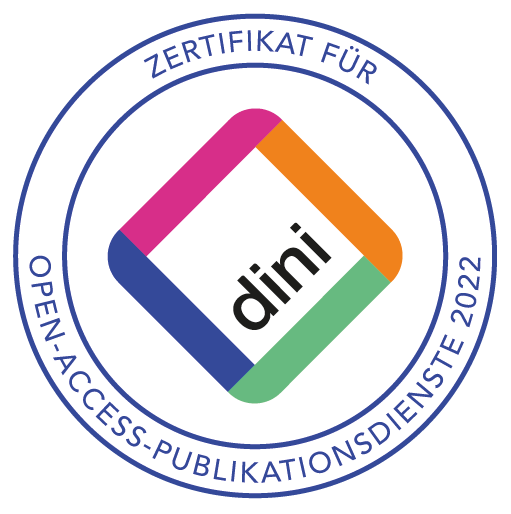Zeithistorische Forschungen
Refine
Year of publication
Document Type
- Journal Article (98)
Language
- English (98) (remove)
Has Fulltext
- yes (98)
In this issue
(2024)
As the sociologist Wolf Lepenies asserts in his ›Brief Cultural History of Re-reading‹, ›The second reading – not the first – determines the value of a book.‹ We have now published one hundred articles under the ›Literature Revisited‹ rubric. Nicolas Berg’s text in our previous issue, which re-examined Victor Klempererʼs The Language of the Third Reich. LTI: Lingua Tertii Imperii. A Philologist’s Notebook (first published in 1947), showed once again how fruitful it can be to take a closer look at the history of the creation, publication and reception of older works, and to view them anew from current vantage points. ›Literature Revisited‹ is not limited solely to the presentation and discussion of oft-cited classics; we also re-read books and essays that may have received less attention upon their original publication, yet, in light of current issues and questions, have earned more focused attention. For the authors of these contributions, ›Literature Revisited‹ can provide an opportunity for renewed engagement with works that the authors, in their early careers, may have already subjected to intense scrutiny; however, some authors are reflecting on publications that they are encountering for the first time. In any case, this format has proved so stimulating that we will of course continue it – with four articles in the current issue.
This article examines the appropriation of the slogan ›Black is beautiful‹, which had its origins in the US Civil Rights movement, by the West German Christian Democrats in the 1970s – and thus by a party led by white men. The analysis brings into conversation histories that have mostly been treated separately: the political history of the Federal Republic and the Christian Democrats; the history of political chromatics and political communication; and the history of racism and anti-racism in Germany after 1945. While the focus is on a specific election campaign that ran from 1972 to 1976, the aim is to address larger issues: the first decade of the Christian Democrats in opposition at the federal level and their struggle to appear ›modern‹ in a period of rapid change; and constructions of race in a society that had banned the word ›Rasse‹ from its political vocabulary. One conclusion is that the ›Black is beautiful‹ campaign was in many ways a typical product of the Federal Republic in the 1970s. The ways in which the Christian Democrats dealt – or did not deal – with ›race‹ in this instance reflects a general reluctance among West Germans to acknowledge the more subtle forms that racism has taken since 1945, other than state-sanctioned discrimination.
How have Jewish intellectuals reflected on the German language both in relation to and in the aftermath of the ›catastrophe‹? This essay explores one perspective, that of H.G. Adler (Prague, 1910 – London, 1988), a scholar, author, and survivor of the Shoah. Adler’s relationship to and reflections on the German language offer insights into the experience of persecution and survival as well as into the memory and representation of the Holocaust. His vast body of work testifies to both the possibility and the necessity of writing ›after Auschwitz‹, and indeed to the necessity of writing in German after the Holocaust. A survivor of Theresienstadt, Auschwitz, and two satellite camps of Buchenwald (Niederorschel and Langenstein-Zwieberge), Adler went on to write in various forms, from the analytic to the poetic, about National Socialism, antisemitism, and life and death in the concentration and extermination camp system. His scholarly work made an important contribution to establishing the international and interdisciplinary field of Holocaust Studies, and his poetry and novels bear witness to his own personal experiences in the camps, albeit not in a directly autobiographical form.
This article explores the connection between genocide, language and language consciousness by tracing the strange biography of one Yiddish neologism: shabreven. During the Holocaust, the word came to mean both ›looting‹ and ›taking ownerless property‹. It stoked moral and etymological debate among Yiddish speakers in the Warsaw ghetto, while also occupying a prominent position in postwar Polish and Zionist discourses. The term shifted between different semantic, ethical and cultural fields, navigating a delicate balance between various meanings and norms. The discussions around this term help to shed light on key questions: What were the motivations for the study of Holocaust Yiddish neologisms? How did this early postwar Yiddish philological discourse differ from its parallel in German? Shabreven became both a symbol of the genocidal collapse of language and a tool for regaining victim agency in speech.
The Language of Eichmann in Jerusalem. Nazi German and Other Forms of German in the 1961 Trial
(2024)
The Eichmann trial granted the German language a degree of audibility unprecedented in the short history of the State of Israel, with the defendant, the judges, prosecutors, and witnesses frequently resorting to speaking in German. Drawing on archival materials, protocols, footage, and press reports, this article shows how the Eichmann trial brought to the surface several historical tensions around the postwar status of the German language. The various forms of German heard in the courtroom challenged notions of German as a Nazi language and contributed to a gradual mitigation of its status as a tainted language. The article concludes by reassessing Hannah Arendt’s 1963 Eichmann in Jerusalem and specifically her postulate that Eichmann’s language faithfully reflected his mindset. It is argued that Arendt’s understanding of Eichmann’s language echoed prewar ideas on German’s distinctive power.
Few of Hannah Arendt’s declarations have had as enduringly a controversial legacy as the one she gave in her famous 1964 West German television conversation with Günter Gaus, proclaiming uncompromised loyalty to her first language – German – despite Hitler. The statement was misconstrued as a privileging of the language of the perpetrators and expressing a bias against Eastern European Jews. In conversation with the recent ›Taytsh turn‹ (Saul Zaritt) in Yiddish Studies, this article focuses instead on two Yiddish newspaper articles published by Arendt in 1942 and 1944 and explores what I call a ›Taytsh move‹ in Arendtʼs language politics. Taytsh, an alternative name for the Yiddish language meaning, literally, German, foregrounds (Jewish) cultures’ inherent translational mode and interconnectivity with the world that makes and sustains these cultures. Arendt reactivated the inherent unbordered nature of languages – with an awareness of the dangers of monolingualism; for the sake of overcoming reductive constructions of Jewishness and modern identity; against the atomizing forces of fascism.
How will Russia’s war of aggression in Ukraine end? What kinds of political scenarios could stop the suffering and bring stability to the region? Of all the different future scenarios none is particularly encouraging. In particular, the prospect of a ›Finlandized‹ Ukraine has met with near universal rejection. Yet, ever since Russia’s illegal annexation of the Crimea, ›Finlandization‹ of Ukraine has been discussed as a potential solution.
In this issue
(2023)
The Russian war of aggression against Ukraine, now in its second year, has many historical connections and implications – including some which may not immediately spring to mind. The German War Graves Commission estimates that the human remains of more than 800 Wehrmacht soldiers have been uncovered so far over the course of this war, some of them surfacing as new trenches were being dug. Helmets and boots have also been found. Historian Reinhart Koselleck’s (1923–2006) metaphor of Zeitschichten, or temporal layers, acquires here a different meaning and a very concrete materiality. (Koselleck had himself served as a soldier in Ukraine.) In her acceptance speech for the Leipzig Book Award for European Understanding in April 2023, the Russian author Maria Stepanova, who currently lives in Berlin, said: ›Are we condemned to keep reliving the twentieth century with its prisons, concentration camps and propaganda machines, its trench warfare and area bombardments? What can we do when the fabric of language, its texture, suddenly becomes transparent, revealing all the hidden layers of latent and overt violence percolating to the surface?‹
This article builds on the writing of former asylum inmates in the United States to analyze life on asylum wards between 1890 and 1950. Although published accounts of inmates’ experiences in American asylums have their own limitations as primary sources, they are nevertheless very revealing not only of the day-to-day life of institution inmates, but also of the ways in which former asylum inmates made sense of their experiences. The article relies upon insights from Disability Studies and Mad Studies to analyze life on the wards, work and socialization, relations among inmates, clandestine communication channels, and the formation of informal support groups, such as ›suicide clubs‹ in institutions. ›Mad writers‹ were almost equally women and men. They were white, and often well educated. They used the social and economic advantages that many of them had to create a public space from which they could critique the United States’ burgeoning asylum system. These accounts also laid the groundwork for later twentieth-century mad people’s movements.
During the first five-year plan, the Soviet state turned to an unusual source to cope with the challenge of factory-induced deafness and disability: the deaf community. From 1930 to 1937, deaf activists, alongside specialist doctors, organised a yearly, three-day event known as Beregi slukh! (Take Care of Your Hearing!) to propagandise the prevention of deafness. During these years, more than 46,600 lectures were held in venues across the Soviet Union and 7,900,000 brochures, leaflets and posters printed. While the event reflected the Soviet belief that disability was a relic of the ›backward‹ past that would be eliminated as communism approached, the deaf activists involved in these events used them to make the alternative case for their own identity as a legitimate part of the Soviet body politic. By foregrounding their labour capacities and demonstrating aspects of deaf cultural practices (including sign language) to a hearing audience, Beregi slukh! became a powerful means to advocate for the centrality of the deaf community to Soviet visions of self and society.

